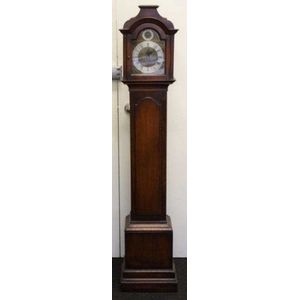English 3-Train Oak Grandmother Clock for Servicing
You must be a subscriber, and be logged in to view price and dealer details.
Subscribe Now to view actual auction price for this item
When you subscribe, you have the option of setting the currency in which to display prices to $Au, $US, $NZ or Stg.
- Oak - Native to Europe and England, oak has been used for joinery, furniture and building since the beginning of the medieval civilisation. It is a pale yellow in colour when freshly cut and darkens with age to a mid brown colour.
Oak as a furniture timber was superceded by walnut in the 17th century, and in the 18th century by mahogany,
Semi-fossilised bog oak is black in colour, and is found in peat bogs where the trees have fallen and been preserved from decay by the bog. It is used for jewellery and small carved trinkets.
Pollard oak is taken from an oak that has been regularly pollarded, that is the upper branches have been removed at the top of the trunk, result that new branches would appear, and over time the top would become ball-like. . When harvested and sawn, the timber displays a continuous surface of knotty circles. The timber was scarce and expensive and was used in more expensive pieces of furniture in the Regency and Victorian periods. - Movement - The technical name for the workings of a clock or watch, and does not include the dial or case.
- Pendulum - The pendulum was discovered around 1602 by Galileo Galilei, and was adopted for time keeping by the Dutch mathematician and natural philosopher, Christiaan Huygens, who excelled in astronomy, physics, and horology.
The pendulum comprises a metal rod usually of brass or steel with a metal disk, known as a bob, at the end. The movement of the pendulum is driven by weights or a spring, and as a pendulum swings in a regular arc, it was found accuracy could be controlled to within a few seconds a week.
Timekeeping can be adjusted by changing the height of the bob on the rod, making the pendulum either swing slower or faster.
The disadvantage of the pendulum was that changes in temperature also changed the length of the pendulum, interfering with the accuracy of the clock, and so in the 18th century two types of mercurial pendulums were invented which countered the movement in the steel rod.
The pendulum was the world's most accurate timekeeping technology until the invention of the quartz clock, regulated by a quartz crystal, in 1927.
This item has been included into following indexes:
-
clocks, grandfather / longcase, type
- grandmother 18
- other 181
Visually similar items

Vintage wall cabinet with glass door and three adjustable shelves, 94 cm high, 63 cm wide

Two Armlets, Kankanay, Philippines (circa 1900), boar's tusks, hair and rattan, tusks 11.5 cm; 12.5 cm wide (2). Provenance: William Beyer, Manila. Acquired from above by Dr Peter Elliott, in the 1960s

Antique music cabinet with serpentine front top and scroll carved back, 48 cm wide, 101 cm high

A solitaire diamond by Paul Bram of 1.44ct. 18ct white gold, handcrafted and retailed by Paul Bram, presented as a beautiful solitaire diamond ring, set with central brilliant cut diamond of known. Weight 1.44ct, accompanied by GIA certification, F/Si, cla
